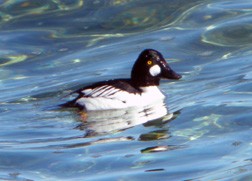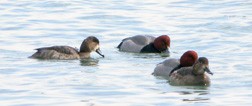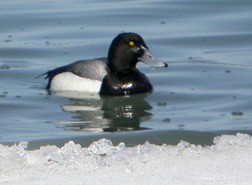Severe Winter Presents Hardships to Wildlife
- Share
- Tweet
- Pin
- Share
Charlotte recently had an email from friends in Florida telling her that the temperature there was in the 70s. Charlotte’s speedy reply was, “We are also in the 70s…72 inches of snow up to now!” She keeps an accurate ongoing tally of the snowfall every winter and this is one of the snowiest and coldest winters here in quite a few years.
Naturally, the snow settles considerably from day to day, resulting in a present snow depth on the level of about 16 to 20 inches at our place.

The drake Common Goldeneye sports a white cheek patch making for easy identification.
Not only has this been a difficult winter for people, with increased heating and snow removal costs, it’s been devastatingly hard on most forms of wildlife. Small rodents beneath the hard-packed and iced-over snow are suffering from lack of food as well as an insufficient supply of oxygen. At the same time the raptors, including both hawks and owls, are experiencing a nearly impossible challenge of getting at the rodents. Statewide the White-tailed Deer are doing poorly with the iced-over deep snow and cold temperatures. The small deer aren’t able to rear up enough to reach the browse, and there have been too many mild years with an ever-increasing population of deer despite hunting pressure.
Living close to Lake Michigan, we take interest in the wintering diving ducks, which have been hurting for food. Due to the extensive ice cover throughout the Great Lakes, there have been many reports of diving water-birds, including ducks, loons etc., moving inland in search of open water. Some have been succeeding but many have not. A report came to us of two Mute Swans sitting on the ice in Jackson Harbor. With no open water within miles, it’s unusual to see birds as large as Mute Swans in this location.
A Long-tailed Duck was observed being mobbed by crows on a parking lot at the corner of Airport and Townline roads on Washington Island. Also on the island, not too far away from Jackson Harbor, a friend told of turning onto the driveway at his office and having a Long-tailed Duck hurriedly fly out of the driveway, below tree level, nearly hitting his windshield with crows in hot pursuit. The friend’s guess was that the shortage of open water has the ducks scouting for food or for open water, or the crows weren’t able to find enough food due to the deep snow cover – or both. When you see a Long-tailed Duck sitting on top of a snowbank along a road with nothing but an endless expanse of white snow in view, where ordinarily there is open water and plenty of available food, you can assume the duck is running out of something to eat and doesn’t have the energy to migrate, or it’s lost and doesn’t know the way, and in a day or two will simply perish.

The drake Redhead’s red head, gray back and black chest contrast from the overall soft tan color of the hen Redhead.
In a more typical winter there are two sites in Door County – Cave Point and the big dock at Northport – which I’ve enjoyed visiting in order to both observe the diving ducks and even to hear especially one of the species. Usually we can expect to see Long-tailed Ducks, Common Goldeneyes, Common and Red-breasted Mergansers, Buffleheads, Lesser and Greater Scaup, Harlequin Ducks, White-winged Scoters, Redheads, Ring-necked Ducks and Common Loons.
There have been winters at both of these sites when I’ve estimated easily more than a thousand of these fascinating Long-tails. Looking across Death’s Door passageway to the north of the Northport dock, toward Plum Island, has provided us with just about every conceivable action and vocalization of the Long-tails. It’s especially later in winter, approaching their time for breeding, that their “growls, clucks, squawks and yodels” could hardly be produced by a duck – but they are! It’s the males’ very vocal musical yodeling, sounding like “ow, ow, owol-ow,” that strikes me as downright hilarious. Then consider several hundred males making the fascinating music at the same time and it’s an unforgettable adventure worth having.
We’ve had a few experiences in past deep-snow winters of a Barred Owl taking up residence very close to our house and garage. Usually there were open runways right next to the foundations where swirling winds blew the snow away from the buildings. These runways turned out to be the preferred trails for mice to follow; the mice in turn became the readily available food for the owl.
Occasionally we were thrilled to hear Screech Owls on a nightly basis and assumed they too were after the mice. However, it is not uncommon for the tiny Screech Owls to become food for the larger Barred and also the Great Horned Owls. Now along comes this year’s unusually deep snow and immediately the owls are presented with a severe shortage of food.
Rehab centers have been receiving unusually high numbers of these small raptors being severely emaciated. The highly skilled rehab people can bring the Screech Owls back to reasonably good health and, with warm weather not too far off, will be able to safely release the owls, which will stand a very good chance of surviving.

The Greater Scaup, this one a drake, is often called the Bluebill.
Up to today, Feb. 25, we’ve already seen a few Horned Larks searching for, most likely, the big nutritious Ragweed seeds along the narrow strips of snowless shoulders along the roads. This is close to the latest we’ve recorded the arrival of what we refer to as the true harbingers of spring. We’ve also been seeing only a very few Snow Buntings along the roadsides. The wide expanses of snow-covered fields, especially those that are somewhat iced over, surely are not to their liking.
Man’s effects on the total bird population is staggering. Conversion of wild habitats into millions of acres of highways, cities and farmland has reduced many species. Drainage of wetlands, erection of thousands of miles of electric transmission wires, construction of scores of high towers and buildings, oil pollution on bodies of water, and tree and crop spraying are only a few of the ways humans affect bird populations.
This winter the more we become aware of the perilous lives most birds lead, the less we complain about the price we pay for the bird food we buy.
